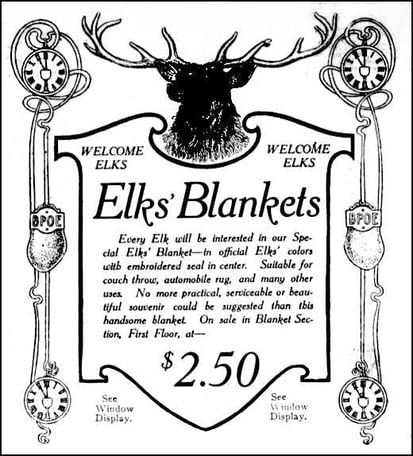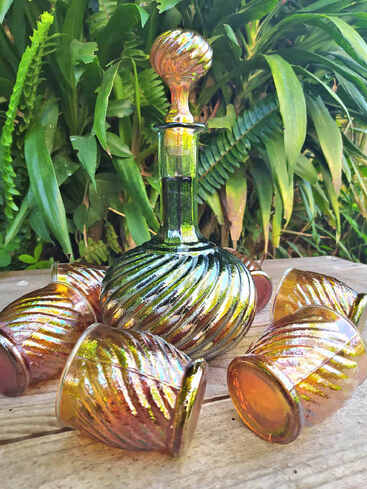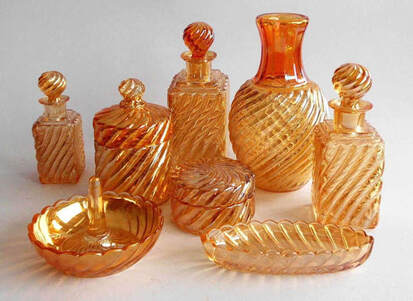NetworK ezine Issue 95. April 2023
Totally Devoted to Carnival Glass
Welcome to our April 2023 NetworK ezine!
Our Carnival NetworK Group on Facebook has now reached an amazing 14,000 Members - that is fourteen thousand Carnival enthusiasts from all around the world. Our Group has a very active membership with constant, lively participation. To join us, there is a Facebook link at the foot of each NetworK Issue.
Our Carnival NetworK Group on Facebook has now reached an amazing 14,000 Members - that is fourteen thousand Carnival enthusiasts from all around the world. Our Group has a very active membership with constant, lively participation. To join us, there is a Facebook link at the foot of each NetworK Issue.
|
The Elks are coming to Town
Turn the clock back to July 1910. A convention is coming to Detroit, Michigan. But this is no ordinary convention – the Elks Convention is coming to town! Estimates vary, but newspapers claimed that nearly a quarter of a million extra people came to the city for the reunion. Everywhere was decorated for the big Elks parade, in fact it was claimed that the decorations surpassed any previously seen. “The greatest automobile parade in history” was reportedly watched by an estimated crowd of 500,000. Health and safety were considered too, as more than 300 doctors offered their services during the Elks convention week. And they brought plenty of dollars with them – as the “Detroit Times” noted, “The visiting Elks, for the most part, are a moneyed crowd”.
So, what did they spend their money on? Souvenirs and more of every kind imaginable, from Elks blankets to jewelry, food, entertainment, and excursions. One notable event laid on for the Elks was the Wright Brothers “Aeroplane Race” at the State Fair Grounds. Above and right: ads in the Detroit Times, 1910
|
1910 Detroit Elks bowl in amethyst, Millersburg.
Photo courtesy Walt Robinson. |
|
And of course … there was Carnival Glass too.
Both Millersburg and Fenton produced souvenirs for the 1910 Detroit Elks Convention. Here are two magnificent paperweights made by Millersburg, shown courtesy Walt Robinson. A contemporary account of glass production at the Millersburg factory when these paperweights (“novelties”) were issued can be seen in the 1910 “Crockery and Glass Journal”, which reported: “Conditions with Millersburg Glass Co. were never better than now. Berry sets have had a very large sale, and the department store and five-and ten-cent trade have sent in liberal business. Paul Joseph has received a substantial consignment of new samples from the Millersburg Glass Co., which embraces items in Crystal and Radium tableware, appropriate for the summer trade. They include lemonade, claret, berry and salad sets, nappies, bowls, and novelties. The wonderful colorings on the Radium glass are new and distinct. Swung vases, water and claret jugs, with tumblers to match, nappies, bowls, and punch sets, have added considerable strength to the famous Radium ware, and finally, the colonial ware has received similar accessions.” Sadly however, 1910 was the peak of Millersburg’s production and fame. As 1911 dawned, the slow and steady collapse of the business took hold. There would be no more Carnival Glass, or BPOE souvenirs from Millersburg. Here are some more Elks treasures, courtesy of Walt Robinson. |
Millersburg Elks paperweights in rare green (left)
and amethyst Carnival. Photos courtesy Walt Robinson. |
|
Two Elks Bells in blue, both made by Fenton.
Left, 1911 Atlantic City, and right, 1914 Parkersburg. Photos courtesy Walt Robinson. |
Above: more Elks pieces made by Fenton, again both are blue.
Left, 1911 Atlantic City ice cream shaped bowl, and right, 1914 Parkersburg plate. Photos courtesy Walt Robinson. |
We hope you have enjoyed this look at the B.P.O.E. Carnival souvenirs. Our grateful thanks to Walt Robinson for his lovely photos.
We have a major feature article on our website, which explores Classic Elks commemorative pieces from 1910 (Detroit), 1911 (Atlantic City), 1912 (Portland) and1914 (Parkersburg), and also Revival Carnival pieces: BPOE Elks - The Story Behind The Glass
We also explore what lay behind the Millersburg factory's very short-lived existence in this two part article: Magnificent Millersburg - The Rise and Fall
An Esberard Beauty
This splendid, marigold decanter set shown on the right was recently discovered by Claudio Deveikis in Brazil. Although the exact items were not depicted in these shapes in the c. 1930s Esberard catalogue, other shapes in this pattern were indeed shown. However, the earlier 1907 Esberard catalogue depicted a very wide range of shapes in the pattern, including a decanter and glasses.
This splendid, marigold decanter set shown on the right was recently discovered by Claudio Deveikis in Brazil. Although the exact items were not depicted in these shapes in the c. 1930s Esberard catalogue, other shapes in this pattern were indeed shown. However, the earlier 1907 Esberard catalogue depicted a very wide range of shapes in the pattern, including a decanter and glasses.
Above: two different sizes of the butter dish in the same pattern, both in marigold.
Photo courtesy of Maria Beatriz de Campos Teixeira Neves Monteiro, and Hélcio Monteiro. Alongside the image is the butter dish as depicted in the Esberard 1907 catalogue. |
Above: marigold decanter set, Esberard, Brazil.
Courtesy Claudio Deveikis. |
|
We will work with Claudio to investigate this Esberard pattern further.
In fact, this whirling style of pattern is a familiar one that can be found on a variety of glass from makers around the world. In Carnival it was made by Northwood, Imperial, Riihimaki, Zabkowice, and others, with various names such as Swirl, Twist, Waltzen, Kierre and Baccarat. Right: various dresser set items in the Waltzen pattern by
Zabkowice, Poland. Courtesy Dirk Dreps. |
A. A. Importing Co.
We came across an interesting page from the A.A. Importing 1996 catalogue, courtesy the Glass Paper Fanatics. The first section shows what is described as “Depression Glass” and “Traditional Iridescent Carnival Glass”. The colour of the items appears to be amethyst or purple.
We came across an interesting page from the A.A. Importing 1996 catalogue, courtesy the Glass Paper Fanatics. The first section shows what is described as “Depression Glass” and “Traditional Iridescent Carnival Glass”. The colour of the items appears to be amethyst or purple.
|
The items shown above are:
PG16330 Carnival Glass Sharon Compote. This is the Cabbage Rose design by Federal Glass, c. 1930s. Not originally known in Carnival. PG16325 Carnival Glass Rooster Dish PG16327 Carnival Glass Santa Sleigh Dish PG16323 Carnival Glass Chicken Dish 8” wide
PG16326 Carnival Glass Cookie Jar 7” high. This is the Mayfair or Open Rose design by Hocking not originally known in Carnival. It is well known in a variety of reproduction colours, but here it is in Carnival. PG16324 Carnival Glass Hen Dish 6.5” wide The catalogue also included this two-piece 7.5" "Cat Dish", PG2600, right. This has previously been something of a puzzle when found by collectors, but here in the A. A. Importing catalogue is the very creature in red Carnival. Although described as a "Dish", it is a 2-piece lidded item.
We have added this catalogue page in its entirety to our website. As well as the Carnival items we show here, there are "slag" glass and non-iridised red glass items, and we know that there are Carnival versions of these other pieces. To see the full catalogue page, click here: A. A. Importing 1996 |
Indiana Glass in 1972
A delightfully arranged selection of Indiana Glass’ Revival era Carnival is shown here, in 1972. Note that the text states that the six items shown are “additions to the line”, which allows us to date when they were originally introduced into production.
The ad itself details each item so no further explanation from us is needed.
A delightfully arranged selection of Indiana Glass’ Revival era Carnival is shown here, in 1972. Note that the text states that the six items shown are “additions to the line”, which allows us to date when they were originally introduced into production.
The ad itself details each item so no further explanation from us is needed.
|
Catalogue image courtesy Glass Paper Fanatics.
|
Note that the 10-inch Hostess “plate” (#2908) shown in the ad only features the plain interior. Unseen is the distinctive patterned exterior that was undoubtedly inspired by Sowerby’s No. 2266 Chunky design produced from 1907 and again from the 1950s. However, another Indiana ad showed the smaller 6.5-inch “plates” (actually ruffled bowls) as a 2 piece Tidbit set, #1197. On this ad above the exterior design can be seen more clearly. |
Click the catalogue image to view it in larger format for study. This will also link to our Indiana Glass Homepage, which has masses of information, pictures and catalogues about Indiana's Revival Era Carnival Glass.
Privacy and the use of your information: we only use your name and email address to send you your Carnival Glass NetworK ezine. We will not share your name or email address with anyone else, or use it for any other purpose. You can change your mind about receiving your NetworK ezine at any time by clicking the unsubscribe link at the foot of every issue, or by emailing us at [email protected]
Join us on Facebook
We invite you and your friends to join us all on NetworK's fast growing and very active Facebook Group (link is below), and if you have missed any of the previous issues of NetworK and NetworK Specials, they are all here: Back Issues.
We invite you and your friends to join us all on NetworK's fast growing and very active Facebook Group (link is below), and if you have missed any of the previous issues of NetworK and NetworK Specials, they are all here: Back Issues.

















